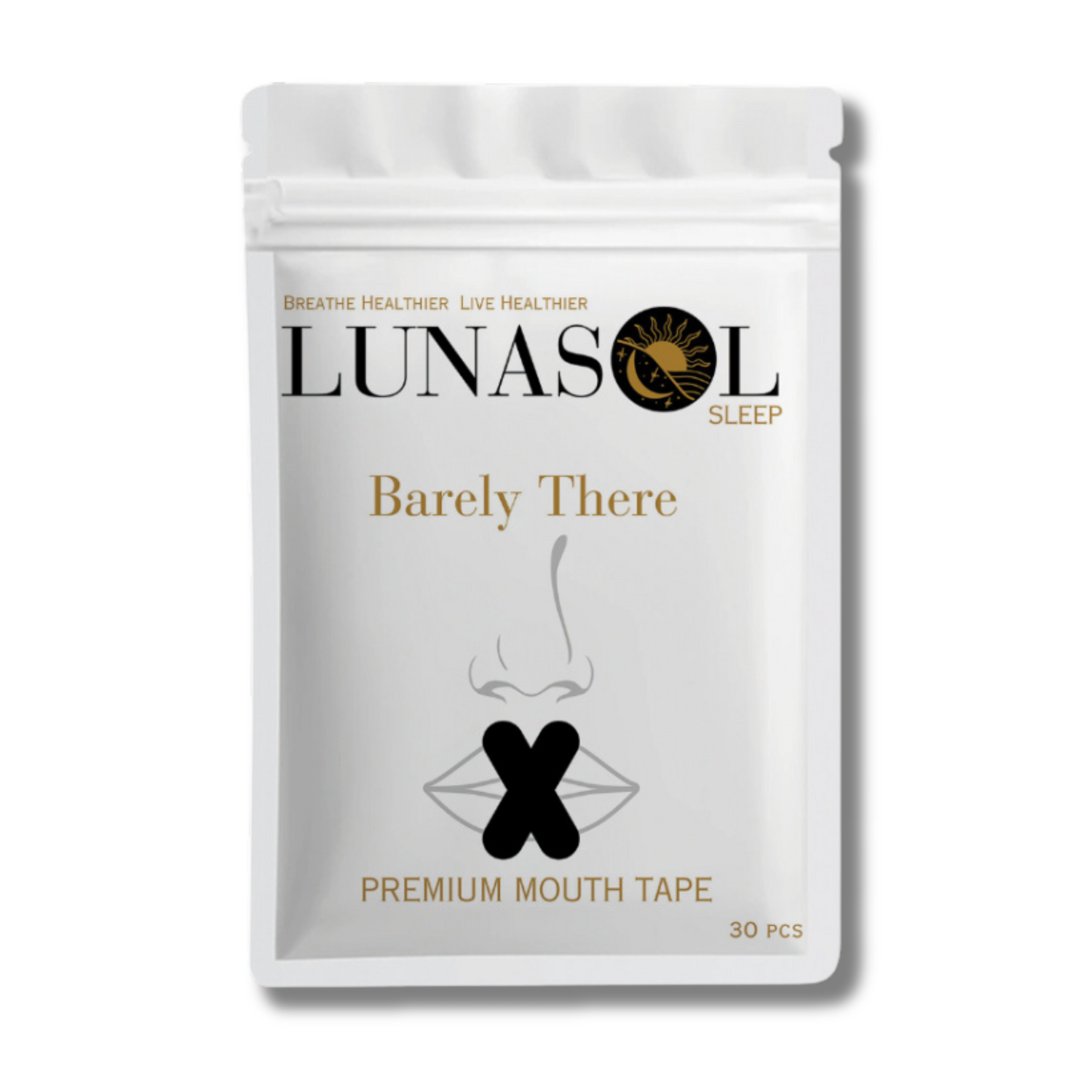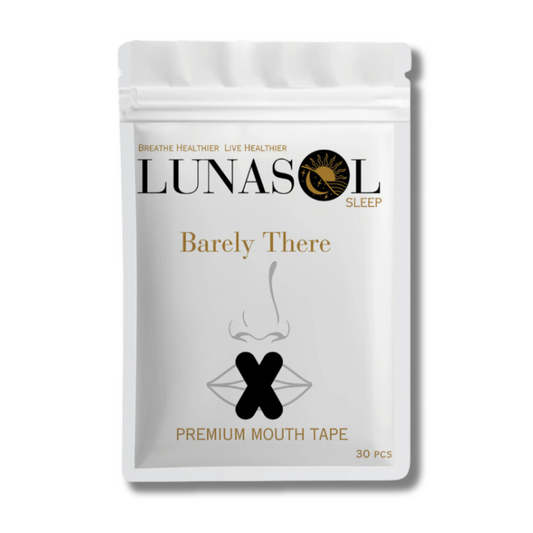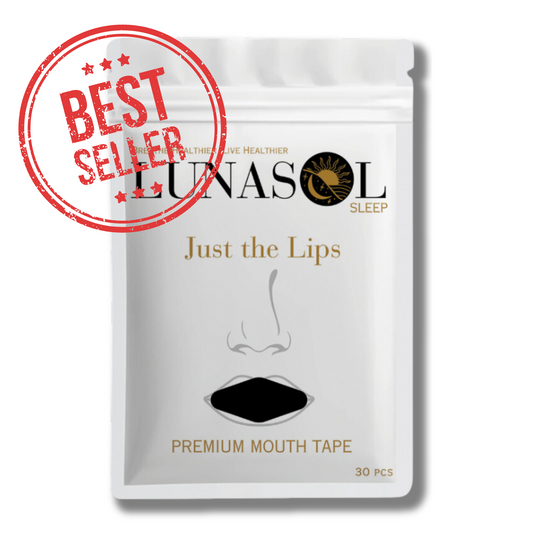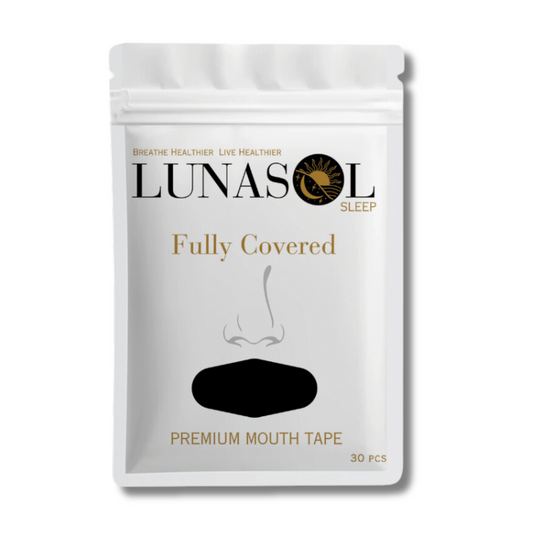Snoring, Sleep Apnea, CPAP and the Simple Solution of Mouth Taping
Snoring and sleep apnea are two interconnected conditions that significantly impact health and quality of life for millions. While snoring is often seen as just a nuisance, it can be a key indicator of obstructive sleep apnea (OSA), a serious disorder that interrupts breathing during sleep and increases the risk of cardiovascular diseases.
Mouth taping, a straightforward intervention, offers a non-invasive way to encourage nasal breathing, which can alleviate the symptoms of sleep apnea and improve sleep quality. By promoting nasal over mouth breathing, it helps maintain an open airway, reducing snoring and the risk of sleep apnea episodes. This simple practice highlights the importance of understanding and addressing the underlying factors of sleep-related breathing disorders, offering a pathway to better sleep and health.
Snoring: Unveiling Its Comprehensive Impact and Connections to Sleep Apnea
Snoring, often dismissed as a mere annoyance, is in fact a pervasive issue with wide-ranging implications for health, sleep quality, personal relationships, and its connection to sleep apnea. This condition, characterized by loud and harsh breathing sounds during sleep, serves as a critical indicator of potential obstructive sleep apnea (OSA) and other underlying health issues.
Prevalence Across Populations: Snoring affects a substantial portion of the adult population, with studies indicating that approximately 40% of adult men and 24% of adult women engage in habitual snoring. This discrepancy underscores the influence of biological differences, including throat anatomy and hormonal factors, on snoring prevalence between genders.
Impact on Sleep Quality: Snoring can significantly compromise the quality of sleep for both the snorer and their partner. The intermittent noises disrupt sleep cycles, leading to fragmented sleep patterns. This disruption can result in excessive daytime sleepiness, decreased alertness, and impaired cognitive function for both individuals.
Health Implications: Beyond its immediate impact on sleep, snoring is a prominent risk factor for obstructive sleep apnea, a condition where breathing stops and starts repeatedly throughout the night. OSA is associated with a higher risk of cardiovascular problems, including hypertension, heart disease, and stroke, due to the recurrent oxygen deprivation and subsequent stress on the cardiovascular system.
Social and Relationship Strain: The effects of snoring extend into the social and emotional realm, often causing friction in relationships. Partners of snorers may experience sleep disturbances leading to irritability, resentment, and even separate sleeping arrangements, which can strain the emotional bond between them.
Significance in Diagnosing Sleep Apnea: Snoring is not only a symptom but also a critical marker for diagnosing sleep apnea. Many individuals remain unaware of their condition until a partner or family member notices their snoring and potential breathing pauses. Early recognition of snoring as a symptom can lead to timely diagnosis and treatment of sleep apnea, mitigating the risk of its associated health complications.
Statistics Highlighting the Issue: The prevalence of snoring underscores its significance as a public health concern. With an estimated 40% of men and 24% of women habitually snoring, the potential for underlying sleep disorders like sleep apnea is considerable. Moreover, the American Academy of Sleep Medicine reports that sleep apnea affects approximately 26% of adults aged 30 to 70, highlighting the overlap between snoring and sleep apnea populations.
Addressing Snoring: Management strategies for snoring range from lifestyle modifications, such as weight loss and avoiding alcohol before bedtime, to medical interventions like Continuous Positive Airway Pressure (CPAP) therapy and oral appliances. These treatments aim to keep the airway open during sleep, reduce snoring, and address the potential for sleep apnea.
By expanding our understanding of snoring and its far-reaching effects, we underscore the need for awareness, timely intervention, and comprehensive treatment strategies. Recognizing snoring as a significant health indicator, rather than a benign annoyance, can lead to improved outcomes for those affected by sleep apnea and other related disorders.
Understanding Sleep Apnea and the Role of Mouth Breathing: Insights and Interventions
Sleep apnea is an all-too common yet frequently overlooked condition that casts a shadow over the lives of millions worldwide, interrupting the essential restorative process of sleep. It's a disorder that knows no bounds, affecting individuals across all age groups, genders, and geographic locations, with an estimated 936 million people aged 30 to 69 affected globally. In the United States alone, the gap between the 30 million sufferers and the mere 6 million who have been diagnosed points to a dire need for enhanced awareness and improved diagnostic and treatment methodologies.
Exploring the Types of Sleep Apnea:
- Obstructive Sleep Apnea (OSA): The predominant form of sleep apnea, OSA occurs when the muscles in the back of the throat fail to keep the airway open, despite efforts to breathe. This can lead to repeated breathing interruptions throughout the night, significantly reducing sleep quality and oxygen levels in the blood.
- Central Sleep Apnea (CSA): Less common than OSA, CSA arises when the brain doesn't send the correct signals to the muscles that control breathing. This condition represents a different type of challenge, as it's more about communication between the brain and the body rather than a physical obstruction.
Unveiling the Health Impacts:
- Diabetes: The link between sleep apnea and diabetes is particularly concerning, with a notable share of individuals with OSA at an elevated risk of developing prediabetes and Type 2 Diabetes. This relationship underscores the importance of managing sleep apnea to prevent or control diabetes.
- Cardiovascular Diseases: The cardiovascular implications of sleep apnea are profound. From doubling the risk of heart attacks to significantly increasing the likelihood of heart failure, coronary heart disease, and atrial fibrillation, the impact of untreated sleep apnea on heart health cannot be overstated.
- Stroke and Mortality: Perhaps one of the most alarming aspects of sleep apnea is its association with an increased risk of stroke and a tripling of the mortality rate, primarily due to cardiovascular complications. These statistics highlight the critical nature of addressing sleep apnea as a major public health issue.
- Cognitive Decline: The effects of sleep apnea extend to cognitive functions, manifesting as attention deficits, memory loss, and diminished executive functioning. Fortunately, effective treatment strategies can offer significant improvements in these areas, further emphasizing the need for timely intervention.
The Significance of Mouth Breathing in Sleep Apnea:
Mouth breathing not only aggravates the symptoms of sleep apnea but also contributes to its development. The natural benefits of nasal breathing, such as air filtration, humidification, and temperature regulation, are circumvented when breathing occurs through the mouth. This can lead to a drying and irritation of the airway, increasing the likelihood of airway collapse during sleep and exacerbating the severity of OSA episodes.
Integrating CPAP Therapy with Mouth Taping for Enhanced Management of Snoring and Sleep Apnea
Snoring and sleep apnea, particularly obstructive sleep apnea (OSA), are intimately linked conditions that can severely affect one's health and quality of life. These conditions not only disrupt sleep for individuals but also pose serious health risks, including increased cardiovascular disease. While mouth taping has emerged as a simple, non-invasive intervention to encourage nasal breathing and alleviate symptoms, Continuous Positive Airway Pressure (CPAP) therapy is the cornerstone treatment for OSA, providing a direct and effective means to keep the airway open during sleep.
The Crucial Role of CPAP Therapy:
CPAP therapy is a highly effective treatment for OSA, designed to prevent airway collapse by delivering a steady flow of pressurized air through a mask. This continuous airflow keeps the airway open, allowing for uninterrupted breathing and significantly reducing the occurrence of apnea events.
- Statistical Evidence of Efficacy: Research has consistently demonstrated that CPAP therapy can dramatically reduce the Apnea-Hypopnea Index (AHI), improving sleep quality and reducing daytime sleepiness. Moreover, CPAP users often experience lower blood pressure and a decreased risk of cardiovascular events.
- Challenges with CPAP Use: Despite its effectiveness, adherence to CPAP therapy remains a significant challenge. Discomfort, noise, and the inconvenience of the device lead to suboptimal compliance rates, with many individuals discontinuing use within the first year.
Mouth Taping as a Complementary Strategy:
Mouth taping, by promoting nasal breathing, offers a complementary approach to CPAP therapy. Nasal breathing is more beneficial for several reasons, including better humidification and filtration of the air. Mouth taping can help mitigate some of the common issues faced by CPAP users, such as dry mouth and air leaks, which are prevalent among those who breathe through their mouths during sleep.
- Enhancing CPAP Comfort and Efficacy: Mouth taping can improve the comfort and effectiveness of CPAP therapy by preventing dry mouth and ensuring that the pressurized air does not escape through the mouth. This can lead to better compliance and a more restful sleep.
- Potential for Reduced Snoring and Apnea Episodes: By facilitating nasal breathing, mouth taping may also contribute to reducing snoring and the severity of sleep apnea episodes, complementing the mechanical support provided by CPAP.
Mouth Taping as a Beneficial Intervention:
Mouth taping, a simple yet effective method to encourage nasal breathing, can be a beneficial intervention for some individuals with sleep apnea. By promoting nasal breathing, mouth taping helps to:
- Optimize Air Intake: Utilizing the nose's natural abilities to filter and condition the air makes breathing easier and less irritating to the airway.
- Reduce Apnea Episodes: Stabilizing the airway through nasal breathing can decrease the frequency and severity of obstructive events during sleep.
- Enhance Overall Sleep Quality: Encouraging consistent nasal breathing can lead to deeper, more restorative sleep patterns by improving oxygen saturation and minimizing nighttime awakenings.
Understanding the complex nature of sleep apnea, its various forms, health impacts, and the role of mouth breathing and potential interventions is crucial for effectively addressing this widespread condition. Enhanced awareness and comprehensive management strategies, including the exploration of supportive treatments such as mouth taping, play a significant role in providing relief to individuals suffering from sleep apnea, thereby improving their overall health and well-being.
Integrating CPAP therapy with mouth taping offers a promising method for managing snoring and obstructive sleep apnea. CPAP effectively addresses the physical obstruction in the airway, while mouth taping promotes the physiological benefits of nasal breathing. This combined approach enhances sleep quality, improves adherence to treatment, and leads to better health outcomes for those with sleep-related breathing disorders. Embracing both technological and behavioral interventions reflects a holistic view of treatment, highlighting the necessity of a comprehensive strategy to tackle the complexities of snoring and sleep apnea.







